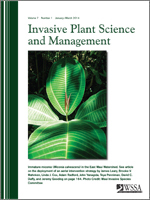The common edible fig is a subcanopy tree that has invaded many of the remnant riparian forests of California's Central Valley. Fig is unusual in its ability to invade low-light, low-disturbance, native-plant–dominated environments. Dendrochronology combined with regression and spatial analyses allowed us to empirically quantify the expansion rate and spatial pattern of the fig invasion into the native plant community at Caswell Memorial State Park (Ripon, CA) over a 70-year invasion period. Fig uses a combination of short-distance dispersal, which results in constant, linear expansion at source population sites and long-distance dispersal, which eventually leads to high recruitment of satellite populations in ideal environments. Although fig initially experienced a long lag in its invasion rate, at the time of this study, it was expanding at an exponential rate at the landscape scale in Caswell. We identified a number of characteristics intrinsic to the fig population (shade suppression, pollinator presence, highly specialized reproduction, and propagule pressure) as well as extrinsic characteristics of the receiving environment (hydrologic alteration from the construction of a dam, safe sites for juvenile recruitment, and target effects from environmental heterogeneity) that may have influenced the rate and pattern of fig invasion. The Central Valley riparian forests have been reduced to less than 6% of their original area, and invasive fig is a significant threat to the remaining fragments of this important vegetation community. We include suggestions for fig eradication based on knowledge gained in this study.
Nomenclature: Fig, Ficus carica L.
Management Implications: Although fig (Ficus carica) initially exhibited a substantial lag in its invasion of Caswell Memorial State Park (Ripon, CA), our study found that it was expanding at an exponential rate 70-yr later. Figs' expansion rate and spatial distribution are influenced both by intrinsic factors (shade suppression, pollinator presence, and highly specialized reproduction), as well as by extrinsic factors (hydrology changes and environmental heterogeneity). Because figs are able to invade the remnant riparian forests of the Central Valley, CA, and form dense groves that exclude native vegetation, they constitute a significant threat to this unique and imperiled habitat. Given fig's ability to expand rapidly once critical, intrinsic and extrinsic conditions are met, it would be prudent for managers of riparian areas to eradicate even small populations of fig.
Based on patterns of invasion at Caswell, floodplain positions that are moist well into spring, such as seasonal sloughs or low-elevation alluvial floodplains, are at greater risk of high levels of fig recruitment. However, as demonstrated in Caswell, even higher-elevation riparian sites are not exempt from fig invasion.
Some research has indicated that when controlling invasive plants, satellite populations should be targeted first because reproduction at the edge of an invader's range substantially increases its rate of expansion. In cases where fig is invading shady riparian forests, however, it may be better to first control reproductive source populations, because figs appear to have an extended nonreproductive juvenile period in these habitats.
Figs' extended juvenile period also means that once all adult and juvenile individuals have been eradicated, follow-up control measures at 5-year intervals should be sufficient to catch figs germinating from the soil seedbank before they become reproductive. Thankfully, our monitoring of former fig-invaded sites at Caswell indicates that fig recruitment from the seedbank may be quite limited, an observation that has also been noted for other Ficus species.





